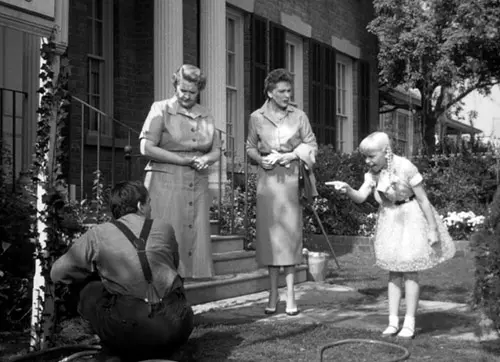LURID: vivid in shocking detail; sensational, horrible in savagery or violence, or, a monthly guide to the merits of the kind of Bad Books you never want your co-workers to know you're reading.
'Tis the season! When it comes to discussing your current reading material with family and friends, you may want to disguise your preference for Bad Books by indulging in the relatively respectable subgenre of psychopath fiction.
Is there a Kevin or a Rhoda in your clan? There’s a special youth version (PCL-Y) of the Hare Psychopathy Checklist-Revised that you can use as a handy diagnostic tool. Take a moment during the festivities to check your young relatives for the following:
- Glibness/superficial charm
- Grandiose sense of self-worth
- Pathological lying
- Cunning/manipulative
- Lack of remorse or guilt
- Shallow affect (genuine emotion is short-lived and egocentric)
- Callousness; lack of empathy
- Failure to accept responsibility for own actions
- Need for stimulation/proneness to boredom
- Parasitic lifestyle
- Poor behavioral control
- Lack of realistic long-term goals
- Impulsivity
- Irresponsibility
- Juvenile delinquency
- Early behavior problems
More info at http://www.hare.org. Also applies to cats.
Sometimes, Bad Books happen to good writers. A usually-literary writer decides to focus their spotlight on a Bad Person, and, voilà! a Bad Book, plumbing the depths of man’s inhumanity to man. Picking a psychopath as protagonist and coating quantities of Bad Book-style thrills with an artistic veneer can prove to be a commercially sound move. Psychopath tomes eschew the trash aesthetic and associations of, say, vampire romance, and a goodly number of them can be found on both bestseller and high school set text lists (Lord of The Flies, anyone?).
Readers gobble up a good psychopath, and many writers have expanded or even found their audience via this route: Iain Banks wrote The Wasp Factory after his earliest attempts at sci-fi met with rejection (he thought “Maybe I should try writing an ordinary, boring, mainstream novel…1” ). Literary writers who pen a Bad Book usually find it’s their most popular work, and that their Bad creation lives on much longer in the imaginations of readers than their more genteel protagonists. Ask Graham Greene (best known for Brighton Rock), Flannery O’Connor (oft-anthologized with A Good Man Is Hard To Find) or Anthony Burgess (synonymous with A Clockwork Orange).
It’s easy to see the appeal. Psychopaths are fascinating when safely caged on the page, and we can check our bourgeois notions of right and wrong at the door when we join them on a literary trip. Reading (and writing) about psychopaths is moral tourism, a joyride through Machiavelliville. There are no consequences and no remorse, just “laughs and lashings of the old ultra-violence”. We’re all supposedly descended from killer apes, so it’s cool to kick back with a book that lets all those maniacal instincts swing loose and low. Everyone’s got an Edward Hyde inside. And, books being books, and not movies with a Hays hangover, we’re allowed to root for the bad guy or gal, who very often doesn’t come to a sticky end. And therein lies the thrill: crime without punishment.
How do you know a proper psychopath when you read one? Dr. Robert Hare’s notorious PCL-R (see panel) outlines the criteria. He defines psychopaths as
predators who use charm, manipulation, intimidation, sex and violence to control others and satisfy their own selfish needs. Lacking in conscience and empathy, they take what they want and do as they please, violating social norms and expectations without guilt or remorse. What is missing, in other words, are the very qualities that allow a human being to live in social harmony.”
Given that “pathological lying” and “cunning/manipulation” are two key traits, pyschos are not always easy to spot. There are a lot of delusional, homicidal and plain screwball characters out there who aspire to the label but don’t quite cut it when it comes to “impulsivity” and “grandiose sense of self worth”. Hannibal Lecter’s empathy for Clarice Starling rules him out for a start, as does his controlled behavior and long-term planning skills. Bill Sikes might strike terror into the heart of every street urchin in Victorian London, but he’s never going to score well on “superficial charm”. Psychopaths may not necessarily be killers, but they will always derive pleasure from destroying others’ peace of mind. Whatever niche psychopaths occupy in life, their cruelty, low boredom threshold and callousness make them dangerous to be around.
 UK investigative reporter Jon Ronson puts the PCL-R through its paces in his excellent The Psychopath Test: A Journey Through The Madness Industry. Abetted by Scientologists hoping to hammer another nail in psychiatry’s coffin, Ronson gains unprecedented access to ‘Tony’, locked up in England’s highest security psychiatric hospital, Broadmoor. Tony claims he faked being a psychopath in order to be declared unfit for trial. Now, he wants out, and the Scientologists are doing everything they can to facilitate his release, on the grounds that his diagnosis is a prime example of just how foolish psychiatry can be. However, the authorities at the former Criminal Lunatic Asylum, final home of Ronnie Kray, current domicile of Peter Sutcliffe, aren’t in the habit of releasing their patients. A doctor explains to Ronson that “faking mental illness to get out of a prison sentence… is exactly the kind of deceitful and manipulative act you’d expect of a psychopath. ” And they like to keep known psychopaths safely under lock and key.
UK investigative reporter Jon Ronson puts the PCL-R through its paces in his excellent The Psychopath Test: A Journey Through The Madness Industry. Abetted by Scientologists hoping to hammer another nail in psychiatry’s coffin, Ronson gains unprecedented access to ‘Tony’, locked up in England’s highest security psychiatric hospital, Broadmoor. Tony claims he faked being a psychopath in order to be declared unfit for trial. Now, he wants out, and the Scientologists are doing everything they can to facilitate his release, on the grounds that his diagnosis is a prime example of just how foolish psychiatry can be. However, the authorities at the former Criminal Lunatic Asylum, final home of Ronnie Kray, current domicile of Peter Sutcliffe, aren’t in the habit of releasing their patients. A doctor explains to Ronson that “faking mental illness to get out of a prison sentence… is exactly the kind of deceitful and manipulative act you’d expect of a psychopath. ” And they like to keep known psychopaths safely under lock and key.
This is Ronson’s Catch-22. Could polite, articulate Tony, with his charm and his pinstripe suit, be the victim of a misdiagnosis? Or could he be a genuine psychopath using his inbred cunning to pass his psychopathic traits off as fake? Ronson honestly doesn’t know. Subsequently, with the PCL-R as his guide, Ronson starts seeing psychopaths everywhere, from big business boardrooms to his own bathroom mirror. His conclusions are sobering: many psychopaths (around 1% of the population) occupy positions of power, having fallen upwards away from co-workers who no longer want to deal with them. Psychopaths rule our world.
Where do all these unpleasant individuals come from? And where do they spend the holidays? Armed with Ronson’s insights, spotting psychopaths makes good sport this time of year, as you’re brought into close proximity with members of your family. Once you’ve learned the essentials of the Hare test, it’s time to assess which of your smiling relatives is secretly fizzing with homicidal rage.
Start with the kids in your tribe; the younglings may not yet be adept at hiding their true nature. Psychopathic poppets drive the narratives of an especially sinister breed of Bad Book. Conventional Horror, such as Henry James’ The Turn of The Screw (1898) or William Peter Blatty’s The Exorcist (1971), sticks with a pre-psychiatry view of the human mind and offers supernatural excuses for brattish behavior. These authors imply that the intrinsic innocence of children can only be corrupted if it comes into contact with evil. Miles was an angel before he met Peter Quint. Regan was a happy little girl until possessed by Pazuzu. Even now, it takes a brave author to challenge the Romantic ideal of children as closer to God.
This is what makes killer kids such a good read. The Horror in these books comes from the subversion of the normal bond between mother and child. These mothers are horrified by their own flesh and blood, but cannot dissolve their sense of connection and responsibility towards their psychopathic progeny. They're trapped, by that most familiar of familial bonds.
The Bad Seed
William March was a marginal writer at the end of a low-key career when he published The Bad Seed in 1954, weeks before his death. It was an instant hit, adapted into a Broadway smash that same year, and then a popular movie. The novel tapped into the zeitgeist when it came to disenchantment with psychoanalysis (one character, Monica Breedlove, never lets her friends forget that she was personally psychoanalyzed by the good Dr. Freud himself). A whole generation had grown up and grown old with “the talking cure”, but they and their kids were still as fucked up as ever. Freudian theory had been superseded by biological psychiatry, which posited a chemical, physical cause for most mental illnesses. And, the previous year in Cambridge, Francis Crick had boasted in a pub of finding “the secret of life” with his research partner, James D. Watson, as they mapped the double helix. Half a century before the MAO-A gene was even identified, March was bang on the money with Rhoda, a born psychopath, her predilection for murder derived directly from her DNA.
March’s chilling narrative takes place over the course of a long hot summer. Fussy blonde eight year old, Rhoda Penmark, lives with her might-as-well-be-single Mom, Christine, in an apartment building stacked with older ladies who dote on the precocious moppet, whose hobbies include embroidery and keeping her dress clean. She’s a classic psychopath, ticking all of Hare’s boxes. She’s described as
one of the most satisfactory pupils the school had ever had. She’d never been absent a single day: she’d never been tardy; she was the only child in the history of the school who’d made a hundred in deportment, each month, in the classrooms, and a hundred in self-reliance and conservation, on the playgrounds, for a full school year… the other pupils both feared and detested Rhoda. ”2

Christine’s doubts about her daughter’s perfect facade are fuelled by the death-by-drowning of one of Rhoda’s classmates. Although no one can tie Rhoda to Claude’s demise, suspicion lingers, just as it did around the death of the Penmarks’ elderly neighbor in Baltimore the previous year. Odd-job man (and possible psychopath in his own right) Leroy also recognizes that there’s something off about the Penmark kid, and takes every opportunity to taunt her with tales of a special pink, child-sized electric chair that’s just waiting for a girl like her. As the summer vacation progresses, Christine connects Rhoda to her half-forgotten family history, and realizes that Rhoda is just like Grandma. There’s no logical way Christine can be blamed for this instance of “blood will out”, but she angsts about it anyway, absolving the absent father of all blame in one of her frequent letters:
The problem is mine and I must solve it alone. I alone am responsible. It was I who carried the bad seed that made her what she is, not you.”3
When Leroy falls victim to yet another fatal accident that may or may not have something to do with Rhoda, Christine is forced to seek the ultimate solution. Be warned: the book (free from Hays Code restrictions) ends very differently than the film.
We Need To Talk About Kevin
Eva Katchadorian, the protagonist of Lionel Shriver’s international bestseller is brought to traumatized, guilty screen life via a superb performance from Tilda Swinton in the movie (released this week). On the page she's more garrulous, more self-abasing, but she would still find a true soul sister in Christine Penmark. Both women suffer psychological abuse at the hands of their monstrous spawn, and write long, rambling letters to their absent husbands about the pain their children put them through. Although neither Kevin nor Rhoda are in the habit of befriending other kids, it would be fun to see the two of them hanging out for an afternoon while their Moms get some girl time – just make sure the family pet is elsewhere and the cleaning closet has a sturdy padlock on the door.
Unlike Christine, Eva suspects Kevin of something from the very beginning, but she can never give it a name. Shriver batters that last taboo, the sanctity of motherhood, by exploring Eva’s lack of maternal feeling while Kevin is still in utero:
Any woman whose teeth have rotted, whose bones have thinned, whose skin has stretched, knows the humbling price of a nine-month freeloader… The whole time I was pregnant with Kevin I was battling the idea of Kevin, the notion that I had demoted myself from driver to vehicle, from householder to house.”4
As soon as Kevin is born, Eva sees him as callous, manipulative, easily bored, parasitic and impulsive, to the bemusement of her husband. Unlike Christine, she has no blood meridian to follow when it comes to sourcing her bad seed. Kevin just came, and she has to deal with this ball of black bile as best she can. He's her own flesh and blood, but she fears him, even thinks he's sexually harassing her once he reaches his teens. And he regards her with equal antipathy.
“Ever occur to you,” he said slyly, “maybe I didn’t want to have you?”
“...Honestly, Kevin – would you want you? If there’s any justice, you’ll wake up one day with yourself next to your bed in a crib.”5
In her impassioned letters, Eva details the life of her son, and his inevitable entry into the pantheon of late ‘90s school shooters. We know from the start that it all ends in tears, but, like Eva, need to go through the process of panning the past for nuggets of cause and effect. With psychopaths, however, there are none. Eva admits to being fascinated by her son, obsessed even with his complex differences. Shriver cuts to the quick on many social issues through Eva’s heart-searching rants; parenting, entitlement, privilege, and violence in the media. Kevin, and his climactic Grand Guignol gesture, is both a self-construct, and a poster child for the times. Our need to talk about Kevin created him. When faced by a documentarian’s camera, he declares:
All you people watching out there, you’re listening to what I say because I have something you don’t: I got plot. Bought and paid for… I give good story. It may have been kinda gory, but admit it, you all loved it. You ate it up. Nuts, I ought to be on some government payroll. Without people like me, the whole country would jump off a bridge, ‘cause the only thing on TV is some housewife on Who Wants To Be A Millionaire? Winning $64,000 for remembering the name of the president’s dog.”6
Reluctantly, his mother agrees with his “flashy thesis”:
I was struck despite myself by what a sizable proportion of our species feeds off the depravity of a handful of reprobates, if not to earn a living, then to pass the time. It isn’t only journalists, either… Film-makers generating millions by dramatizing the predations of lone-serial killers… the courts, police, National Guard – how much of government is the management of the wayward 1%? With prison building and warding one of the biggest growth industries in the United States, a sudden conversion to civilization across the board could trigger a recession.”7

So it seems like we need psychopaths as a society. Maybe we’re lucky there is no cure? While you can use Ronson, Marsh, and Shriver et al to help you identify the viper nestling at your own family’s breast, it might be best to leave them there, for now. Just don’t buy them a crossbow for Christmas – like Kevin’s indulgent Dad. Or let them see your holiday reading - this is a dead giveaway that you’re onto their psychopathic little games. And you don't want to end up like Leroy.
Next month, we’ll take a look at the Rhodas and Kevins who made it into adulthood; grown up psychopaths and their enduring literary allure. In the meantime, feel free to nominate your favorite fictional monster children in the comments below.
Happy Holidays!
1. http://www.guardian.co.uk/books/2008/jul/12/saturdayreviewsfeatres.guardianreview5
2. The Bad Seed by William March (The Ecco Press, 1954) p.26
3. Ibid, p.174
4. We Need To Talk About Kevin by Lionel Shriver (Harper Perennial, 2006) p.60
5. Ibid, p.58
6. Ibid, p352
7. Ibid, p.353

About the author
Karina Wilson is a British writer based in Los Angeles. As a screenwriter and story consultant she tends to specialize in horror movies and romcoms (it's all genre, right?) but has also made her mark on countless, diverse feature films over the past decade, from indies to the A-list. She is currently polishing off her first novel, Exeme, and you can read more about that endeavor here .







